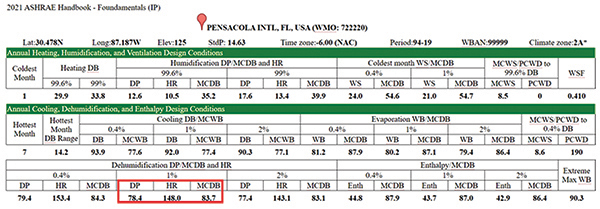Load calculation software inputs are usually Dry Bulb (DB) and Relative Humidity (RH). You’ll have to plug in MCDB and either DP or HR into a psychrometric calculator to find the RH.
With these values in hand, you can save a copy of your completed load calculation, manually enter the peak dehumidification conditions, and re-run the calculation to find the true peak latent load.
Once you do this, you will likely find that the latent load is higher than that calculated for peak cooling conditions, as shown in Figure 2.

In this approximately 1,700-sq. ft. home in Pensacola, the sensible cooling load for the peak dehumidification conditions is around 26% lower than the peak sensible load, but the latent load is around 50% higher.
Be sure to check the equipment’s latent capacities at both the cooling design conditions and dehumidification design conditions, and remember that the equipment will be operating at less than full capacity at the dehumidification design conditions.
In this case, the equipment will operate at about 75% sensible capacity (14,503 ÷ 19,565).
So, we should assume we’ll get about the same percentage latent capacity at the dehumidification design conditions and will likely need supplemental dehumidification.
Equipment Selection
Since we know the home’s load, we can now focus on equipment selection. Again, dehumidification is maximized when the cooling capacity matches the peak cooling load as closely as possible. However, we also have heating to consider. In Figure 3, the heating load closely matches the cooling load, so the selection is straightforward.
In cooler, humid climates, heating load may greatly exceed cooling load, so we must decide whether to select equipment based on heating or cooling requirements. There are arguments for both ways on this question.
If you size to the heating load, you will likely have to provide a dedicated dehumidifier to maintain acceptable humidity levels in the home. Why? Because the system will cycle off too often under lower load, high humidity conditions.
If you size to the cooling load, then you will need to provide supplemental heating, typically with inefficient electric resistance heat that can make heating bills skyrocket.
Click Below for the Next Page:













Recent Comments